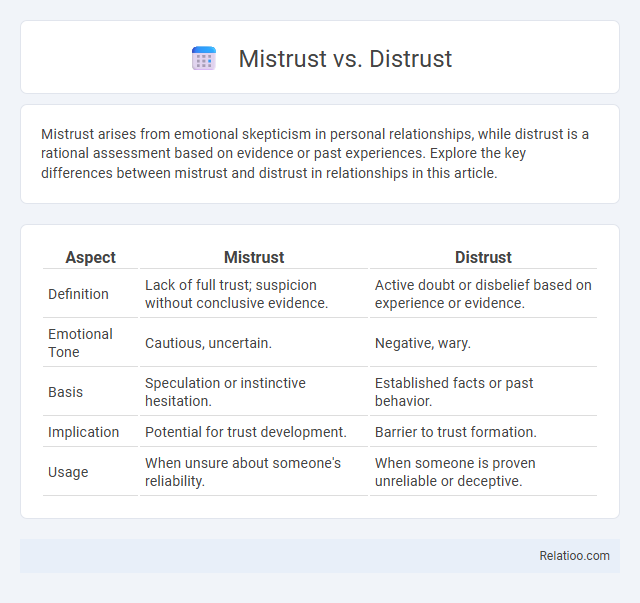Mistrust arises from emotional skepticism in personal relationships, while distrust is a rational assessment based on evidence or past experiences. Explore the key differences between mistrust and distrust in relationships in this article.
Table of Comparison
| Aspect | Mistrust | Distrust |
|---|---|---|
| Definition | Lack of full trust; suspicion without conclusive evidence. | Active doubt or disbelief based on experience or evidence. |
| Emotional Tone | Cautious, uncertain. | Negative, wary. |
| Basis | Speculation or instinctive hesitation. | Established facts or past behavior. |
| Implication | Potential for trust development. | Barrier to trust formation. |
| Usage | When unsure about someone's reliability. | When someone is proven unreliable or deceptive. |
Understanding Mistrust and Distrust: Key Definitions
Mistrust refers to a general feeling of doubt or suspicion towards someone or something without definite evidence, often based on past experiences or intuition. Distrust is a stronger, more explicit lack of trust, typically accompanied by a belief that the other party might cause harm or act dishonestly. Understanding the nuanced differences between mistrust and distrust is crucial for effectively addressing communication barriers and building healthier interpersonal or organizational relationships.
The Psychological Roots of Mistrust vs Distrust
Mistrust originates from past experiences of betrayal or inconsistency, leading to a generalized wariness toward people or institutions, often rooted in early childhood interactions and attachment disruptions. Distrust involves a more active suspicion and doubt regarding others' intentions, frequently arising from observed evidence or logical assessments rather than emotional responses. Understanding these psychological roots reveals that mistrust is typically a deeper, more pervasive emotional state, while distrust is a cognitive stance based on reasoning and critical evaluation.
Historical Examples of Mistrust and Distrust
Historical examples of mistrust and distrust highlight key differences: mistrust often involves a general skepticism without direct evidence, as seen in early Cold War tensions where nations doubted each other's intentions without concrete proof. Distrust involves specific evidence leading to suspicion, exemplified by the Watergate scandal, which eroded public trust in the U.S. government. Your understanding of these terms deepens by recognizing mistrust as a broader, more generalized feeling, while distrust arises from confirmed breaches or deceptive actions.
Linguistic Differences: Usage in Everyday Language
Mistrust refers to a general feeling of doubt or suspicion without specific evidence, often used when you question someone's intentions or reliability. Distrust implies a stronger, more active reluctance to trust based on past experiences or concrete reasons, frequently appearing in legal or formal contexts. The subtle distinctions in usage influence how you interpret relationships and communication, affecting clarity in everyday language.
The Emotional Impact of Mistrust and Distrust
Mistrust and distrust both evoke feelings of insecurity and apprehension, yet mistrust often stems from uncertainty or lack of information, while distrust is rooted in explicit doubts about someone's integrity or reliability. The emotional impact of mistrust can lead to anxiety and hesitation, hampering open communication and collaboration. Distrust, however, frequently results in deeper emotional wounds such as resentment and betrayal, negatively affecting relationships and trust-building efforts over time.
Effects on Relationships: Mistrust vs Distrust
Mistrust subtly erodes the foundation of your relationships by fostering doubt and uncertainty, leading to emotional distance and weakened communication. Distrust, often more explicit and concrete, causes active suspicion and skepticism, resulting in defensive behaviors and potential conflicts. Both mistrust and distrust create barriers to intimacy and collaboration, undermining the trust necessary for healthy, lasting connections.
Mistrust in Institutions: Causes and Consequences
Mistrust in institutions arises from perceived inconsistencies, lack of transparency, and repeated failures to meet public expectations, deeply impacting societal cohesion. Your skepticism often stems from historical injustices, misinformation, and erosion of accountability, which undermine confidence in governance, healthcare, and financial systems. This widespread mistrust can lead to decreased civic engagement, lower compliance with regulations, and broader challenges in policy implementation.
Distrust in Leadership and Governance
Distrust in leadership and governance arises when there is a consistent failure to meet public expectations, leading to skepticism about leaders' intentions and decisions. This erosion of confidence hampers effective policy implementation and weakens institutional legitimacy. Distinct from mistrust, which can be based on uncertainty or lack of information, distrust often stems from perceived deception, corruption, or incompetence in governing bodies.
Rebuilding Trust: Strategies to Overcome Mistrust and Distrust
Rebuilding trust after experiencing mistrust and distrust requires consistent transparency, open communication, and accountability to demonstrate reliability and honesty. Strategies include actively listening to concerns, validating emotions, and delivering on commitments to strengthen relationships and repair damaged perceptions. Establishing clear boundaries and fostering empathy can accelerate overcoming mistrust and distrust, ultimately restoring confidence and cooperation.
Mistrust vs Distrust: Practical Implications in Modern Society
Mistrust and distrust both involve a lack of trust but differ in nuance and application; mistrust is a general skepticism often based on intuition, while distrust is a conscious decision rooted in evidence or experience. Understanding this distinction helps you navigate interpersonal relationships and institutional interactions more effectively, as your responses will be better aligned with the nature of trust issues involved. In modern society, recognizing whether your doubt stems from mistrust or distrust can improve communication, decision-making, and conflict resolution strategies.

Infographic: Mistrust vs Distrust
 relatioo.com
relatioo.com